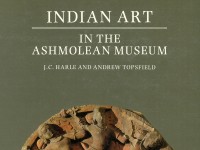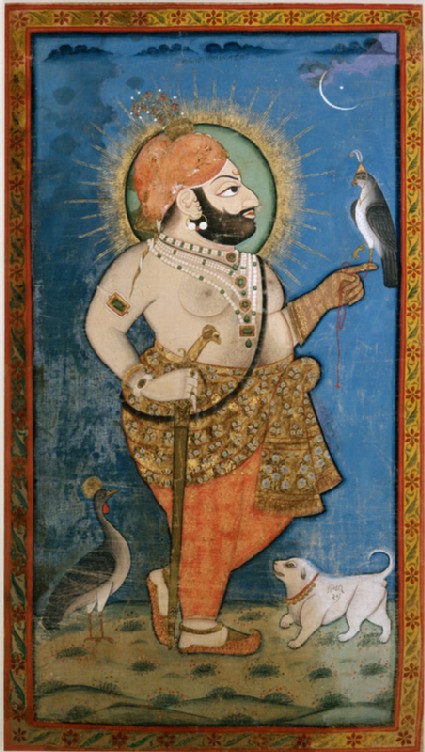Indian Art in the Ashmolean Museum
A catalogue of the Ashmolean’s collection of Indian art by J. C. Harle and Andrew Topsfield (published Oxford, 1987).

Publications online: 143 objects
- Reference URL
Actions
Maharana Bhim Singh with a hawk
-
Literature notes
During the second half of the 18th century the Rajput kingdoms suffered a general decline along with the central Mughal power, being ravaged repeatedly by Maratha invaders from the south. Peace and order were only restored when the Mahārājas accepted British protection in 1818. These decades of adversity encouraged a hedonistic tendency in the once formidable Rajput nobility. One such escapist was Mahārāna Bhīm Singh for fifty years the ruler of Mewar (1778-1828). Colonel Tod, who knew him well, writes in his Annals and antiquities of Rajasthan: “…though able, wise and amiable, his talents were nullified by numerous weak points. Vain shows, frivolous amusements, and an ill-regulated liberality alone occupied him…”. Weak willed and uninterested in administration, Bhim Singh fathered more than a hundred children. Intimate scenes of his private life as well as his public appearances were often painted by Chokha, one of the leading Mewar artists, whose squat well-rounded and large-eyed figures are very distinctive. Most of Chokha’s pictures are small scale works on paper: larger cloth-paintings such as this are generally rare in Rajasthani painting.
Although at first sight a conventional standing portrait of a ruler after the earlier Mughal manner, Chokha’s depiction of his rotund and hairy-chested patron is unusually informal. Bhīm Singh stands nonchalantly with one foot tucked behind the other – the bejewelled hawk on the royal finger also perches on one leg – with a flowered gold sash (paṭka) swathed round his ample hips. However, the Mahārāṇa’s head is shown in full glory, the gold and green nimbus and the crescent moon symbolising the divine ancestors of the Mewar rulers. The painting, which has suffered from water-staining at the left side, is inscribed with Bhīm Singh’s name and a valuation of 20 rupees (written on the side of the sub-nosed, Chokha-esque dog). -
Description
Bhim Singh (r.1778-1828) is shown unusually by his leading painter Chokha, bare-chested and in a nonchalant stance, with a hawk perched on his finger.
-
Details
- Associated place
-
Asia › India › west India › Rajasthan › south Rajasthan › Udaipur (place of creation)
- Date
- 1805 - 1810
- Artist/maker
-
attributed to Chokha (active 1799 - c. 1826) (artist)
- Associated people
-
Bhim Singh, Maharana of Mewar (ruled 1778 - 1828) (subject)Bhim Singh, Maharana of Mewar (ruled 1778 - 1828) (named on object)probably Bhim Singh, Maharana of Mewar (ruled 1778 - 1828) (commissioner)
- Material and technique
- gouache with gold on cotton cloth
- Dimensions
-
page 107 x 59 cm sight size (height x width)
painting without border 95 x 49.8 cm sight size (height x width)
- Material index
- Technique index
- Object type index
- No. of items
- 1
- Credit line
- Purchased with the assistance of the Friends of the Ashmolean Museum, 1985.
- Accession no.
- EA1985.31
-
Further reading
Harle, J. C., and Andrew Topsfield, Indian Art in the Ashmolean Museum (Oxford: Ashmolean Museum, 1987), no. 90 on p. 81, pl. 17 (colour) & p. 81
Topsfield, Andrew, Indian Paintings from Oxford Collections, Ashmolean Handbooks (Oxford: Ashmolean Museum in association with the Bodleian Library, 1994), no. 37 on p. 76, p. 6, illus. p. 77
Bradford: Bradford Art Galleries and Museums, 24 September-27 December 1988, and London: Zamana Gallery, 13 April-25 June 1989, A Golden Treasury: Jewellery from the Indian Subcontintent, Susan Stronge, Nima Smith, and J. C. Harle, eds., Victoria and Albert Museum Indian Art series (London: Victoria and Albert Museum in association with Mapin, 1988), illus. 36
Location
-
- currently in research collection
Objects are sometimes moved to a different location. Our object location data is usually updated on a monthly basis. Contact the Jameel Study Centre if you are planning to visit the museum to see a particular object on display, or would like to arrange an appointment to see an object in our reserve collections.
Publications online
-

Indian Art in the Ashmolean Museum
During the second half of the 18th century the Rajput kingdoms suffered a general decline along with the central Mughal power, being ravaged repeatedly by Maratha invaders from the south. Peace and order were only restored when the Mahārājas accepted British protection in 1818. These decades of adversity encouraged a hedonistic tendency in the once formidable Rajput nobility. One such escapist was Mahārāna Bhīm Singh for fifty years the ruler of Mewar (1778-1828). Colonel Tod, who knew him well, writes in his Annals and antiquities of Rajasthan: “…though able, wise and amiable, his talents were nullified by numerous weak points. Vain shows, frivolous amusements, and an ill-regulated liberality alone occupied him…”. Weak willed and uninterested in administration, Bhim Singh fathered more than a hundred children. Intimate scenes of his private life as well as his public appearances were often painted by Chokha, one of the leading Mewar artists, whose squat well-rounded and large-eyed figures are very distinctive. Most of Chokha’s pictures are small scale works on paper: larger cloth-paintings such as this are generally rare in Rajasthani painting.
Although at first sight a conventional standing portrait of a ruler after the earlier Mughal manner, Chokha’s depiction of his rotund and hairy-chested patron is unusually informal. Bhīm Singh stands nonchalantly with one foot tucked behind the other – the bejewelled hawk on the royal finger also perches on one leg – with a flowered gold sash (paṭka) swathed round his ample hips. However, the Mahārāṇa’s head is shown in full glory, the gold and green nimbus and the crescent moon symbolising the divine ancestors of the Mewar rulers. The painting, which has suffered from water-staining at the left side, is inscribed with Bhīm Singh’s name and a valuation of 20 rupees (written on the side of the sub-nosed, Chokha-esque dog).
Galleries
Notice
Object information may not accurately reflect the actual contents of the original publication, since our online objects contain current information held in our collections database. Click on 'buy this publication' to purchase printed versions of our online publications, where available, or contact the Jameel Study Centre to arrange access to books on our collections that are now out of print.
© 2013 University of Oxford - Ashmolean Museum


